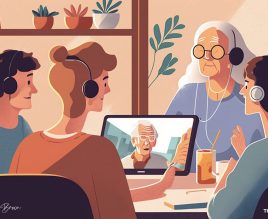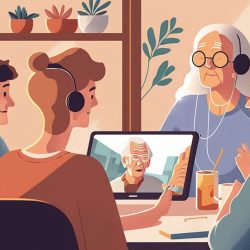Table of Contents
ToggleAs the global population ages, there is an increasing demand for solutions that cater to the unique needs of seniors, particularly when it comes to enabling them to continue living independently and safely in their own homes. Home care technology has risen to the occasion, providing an array of cutting-edge devices and systems designed to support and enhance the lives of older adults. These innovations not only offer a sense of autonomy for seniors, but also peace of mind for their families and caregivers.
In this blog post, we will explore the world of home care technology for seniors, shedding light on the most popular options currently available, their benefits, and the challenges faced during implementation. Furthermore, we will discuss the potential for customization to meet individual needs, address privacy concerns that may arise, and provide insights into what the future may hold for this rapidly growing and transformative sector. Join us as we delve into the realm of home care technology and its potential to revolutionize the way seniors live and thrive in the comfort of their own homes.
Overview of Home Care Technology for Seniors
Home care technology encompasses a wide range of devices, systems, and tools designed to assist seniors with daily living tasks, monitor their health and well-being, and enhance their safety at home. These technologies can be tailored to individual needs and preferences, providing customized solutions for different levels of mobility and cognitive function.
Importance of Home Care Technology for Seniors
The growing aging population and increased life expectancy have amplified the need for innovative solutions that enable seniors to live independently and safely in their own homes. Home care technology offers numerous benefits, such as:
- Increased independence: Technologies that assist with daily tasks and monitor health conditions empower seniors to manage their own lives and maintain autonomy.
- Improved safety: Devices like fall detection and prevention tools, medical alert systems, and smart home systems help protect seniors from potential hazards and accidents.
- Reduced caregiver burden: Home care technology can alleviate the strain on caregivers by automating routine tasks and providing remote monitoring capabilities.
- Enhanced quality of life: Seniors can enjoy a greater sense of well-being and happiness thanks to increased independence, safety, and social engagement provided by these technologies.
Factors to Consider when Choosing Home Care Technology

When selecting home care technology for seniors, it is essential to consider the following factors:
- Compatibility with existing devices and systems: Ensure that the chosen technology integrates seamlessly with other devices already in use by the senior.
- Ease of use and accessibility: The technology should be user-friendly, with intuitive interfaces and clear instructions for seniors with varying levels of technological proficiency.
- Customizability: The technology should be adaptable to meet the unique needs and preferences of each individual.
- Affordability: Home care technology should be cost-effective and fit within the senior’s budget.
- Data privacy and security: The chosen technology should have robust measures in place to protect sensitive personal and health information.
Top Home Care Technologies for Seniors
Medical Alert Systems
Medical alert systems serve as wearable devices that enable seniors to call for help in the event of emergencies, such as falls or sudden health issues. These systems typically feature a button that, when pressed, connects the user to a 24/7 emergency response center. Moreover, some medical alert systems come equipped with automatic fall detection and GPS location tracking. Consequently, by offering immediate assistance when required, these devices grant seniors and their families invaluable peace of mind.
Medication Management Tools
Medication management tools, such as pill dispensers and medication reminder apps, help seniors adhere to their medication regimens. Automatic pill dispensers can be programmed to dispense the correct dosage at specific times, while reminder apps send notifications to seniors and their caregivers when it’s time to take medications. These tools not only ensure proper medication adherence but also reduce the risk of overdosing or missing doses.
Fall Prevention and Detection Devices
Falls are a leading cause of injury and hospitalization among seniors. Fall prevention and detection devices, such as sensor mats, wearable sensors, and smart shoe insoles, help mitigate this risk.
Remote Health Monitoring Systems
Remote health monitoring systems allow seniors and their caregivers to track vital health data, such as heart rate, blood pressure, and glucose levels, from the comfort of their own homes. These systems typically use wearable devices or sensors to collect data, which is then transmitted to a secure platform for analysis and review by healthcare providers. By monitoring health trends and detecting potential issues early, these systems can help seniors maintain their well-being and avoid complications.
Smart Home Systems and Automation
Smart home systems and automation technologies can make daily living tasks easier and safer for seniors. Voice-activated assistants, like Amazon Alexa or Google Home, allow seniors to control lights, temperature, and entertainment systems with simple voice commands. Additionally, automated door locks, security cameras, and motion sensors can enhance home security, giving seniors and their families peace of mind.
Communication and Social Engagement Technologies
Technologies like smartphones, tablets, and video conferencing apps enable seniors to stay connected with friends and family, reducing the risk of social isolation and loneliness. Online communities, social media platforms, and virtual reality experiences can provide opportunities for seniors to engage in meaningful activities and maintain social connections, contributing to their overall well-being.
Advantages of Implementing Home Care Technologies for Seniors

Increased Independence
Home care technologies empower seniors to manage their daily lives autonomously. With devices that assist in routine tasks, monitor health, and provide immediate help in emergencies, seniors can maintain their independence while aging in place. This increased autonomy contributes to a greater sense of dignity and self-worth, ultimately enhancing the quality of life.
Improved Safety
By utilizing home care technologies like fall prevention devices, medical alert systems, and smart home security features, seniors can significantly reduce the risk of accidents and injuries. These technologies provide an added layer of safety, ensuring that seniors can continue living in their homes with confidence and security.
Reduced Caregiver Burden
Home care technologies can alleviate the strain on caregivers by automating routine tasks and providing remote monitoring capabilities. This reduction in caregiver workload allows them to focus on more personalized aspects of care and can prevent caregiver burnout. Additionally, these technologies can enable seniors to remain at home longer, delaying or avoiding the need for institutional care.
Enhanced Quality of Life
By promoting independence, safety, and social engagement, home care technologies can significantly improve seniors’ quality of life. With the support of these tools, seniors can continue to enjoy their hobbies, maintain social connections, and live fulfilling lives while aging in place.
Peace of Mind for Families
Knowing that their loved ones are equipped with home care technologies that promote safety and well-being can provide family members with peace of mind. These technologies ensure that seniors have access to immediate assistance in emergencies and help families stay connected, even when they cannot be physically present.
Overcoming Barriers to Adoption of Home Care Technologies
Addressing Affordability Concerns
While some home care technologies can be expensive, it’s essential to consider the long-term benefits and potential cost savings they offer. By reducing the risk of accidents, hospitalizations, and caregiver burnout, these technologies can offset their initial costs over time. Additionally, subsidies, grants, and financial assistance programs may be available to help seniors afford these devices and services.
Ensuring User-Friendliness and Accessibility
To encourage widespread adoption of home care technologies, it’s crucial to prioritize user-friendliness and accessibility. Manufacturers should design products with seniors in mind, incorporating large buttons, clear displays, and intuitive interfaces. Furthermore, seniors and their caregivers should be provided with comprehensive training and support materials to facilitate the effective use of these technologies.
Promoting Awareness and Education
Undoubtedly, raising awareness about the advantages of home care technologies and instructing seniors, caregivers, and healthcare providers on their appropriate use is crucial for surmounting adoption barriers. To this end, community organizations, senior centers, and healthcare providers can play a pivotal role by hosting workshops, seminars, and informational sessions that foster comprehension and embrace of these technologies. In doing so, they will help bridge the knowledge gap and pave the way for broader acceptance and integration of these innovative solutions into the daily lives of seniors.
Collaborating with Healthcare Providers and Caregivers
Close collaboration between healthcare providers, caregivers, and seniors can ensure that home care technologies are effectively integrated into care plans. Regular communication and feedback can help identify areas for improvement, address any challenges, and optimize the overall benefits of these technologies.
Customizing Home Care Technology Solutions for Individual Needs

Assessing Seniors’ Unique Needs and Preferences
To ensure the successful implementation of home care technology, it’s crucial to assess seniors’ specific needs, preferences, and capabilities. This assessment should consider factors such as the senior’s medical conditions, mobility levels, cognitive function, and living environment. By understanding each senior’s unique circumstances, appropriate technology solutions can be identified and implemented.
Tailoring Technology Solutions for Different Levels of Mobility and Cognitive Function
Home care technologies should be adaptable to accommodate seniors with varying levels of mobility and cognitive function. For example, voice-activated assistants can be particularly helpful for seniors with limited mobility, while simplified user interfaces may benefit those with cognitive impairments. Customizing technology solutions in this manner ensures that each senior can fully benefit from these innovations.
Involving Seniors and Caregivers in the Decision-Making Process
Involving seniors and their caregivers in the decision-making process when selecting and implementing home care technologies is crucial for success. By actively participating in the process, seniors and caregivers can provide valuable insights into their needs and preferences, ultimately leading to more effective technology solutions.
Privacy and Security Concerns in Home Care Technologies
Ensuring Data Privacy and Protection
With the increasing use of home care technologies, data privacy and protection have become critical concerns. To safeguard sensitive personal and health information, manufacturers and service providers must implement robust data encryption, secure data storage, and strict access controls. Seniors and caregivers should also be educated on the importance of data privacy and the steps they can take to protect their information.
Safeguarding Against Cybersecurity Threats
As home care technologies become more connected, the risk of cybersecurity threats increases. Manufacturers must prioritize security in their product design, including regular software updates and patches to address vulnerabilities. Seniors and caregivers should also be educated on how to recognize potential threats, such as phishing emails or suspicious links, and follow best practices to protect their devices and networks.
Educating Seniors and Caregivers about Safe Technology Use
Education plays a crucial role in mitigating privacy and security risks associated with home care technologies. Seniors and caregivers should be provided with training and resources that teach them how to use these technologies safely and securely. This may include instructions on creating strong passwords, recognizing and avoiding scams, and following recommended security measures.
The Future of Home Care Technology for Seniors
Emerging Technologies and Innovations
Emerging technologies, such as wearable sensors, robotics, and virtual reality, hold significant potential for enhancing senior care. As these technologies continue to advance, we can expect even more innovative solutions to support seniors in maintaining their independence, safety, and well-being.
The Role of Artificial Intelligence and Robotics
Artificial intelligence (AI) and robotics are poised to play a significant role in the future of home care technology for seniors. AI-powered algorithms can analyze health data, predict potential risks, and provide personalized recommendations, while robotics can assist with daily tasks, mobility, and companionship. As these technologies continue to develop, we can expect a growing integration of AI and robotics into senior care solutions.
Telemedicine and Virtual Care Solutions
Telemedicine and virtual care solutions are becoming increasingly important in senior care. These services allow seniors to consult with healthcare providers remotely, reducing the need for in-person visits and ensuring timely access to medical care. As the demand for telemedicine and virtual care continues to grow, we can expect further advancements in these areas, enhancing seniors’ ability to access high-quality healthcare services from the comfort of their own homes.
Supporting Seniors in Embracing Home Care Technologies

Encouraging a Positive Attitude towards Technology
To support seniors in embracing home care technologies, it’s essential to foster a positive attitude towards technology. This can be achieved by emphasizing the benefits of these tools, such as improved safety, increased independence, and enhanced quality of life. Community organizations, senior centers, and healthcare providers can play a vital role in promoting a positive mindset by hosting events and workshops that showcase the advantages of home care technology.
Providing Training and Technical Support
Comprehensive training and technical support are critical for helping seniors feel comfortable using home care technologies. Manufacturers and service providers should offer user-friendly guides, tutorials, and support materials to facilitate the learning process. Additionally, ongoing technical support should be readily available to address any issues or concerns that may arise during the use of these technologies.
Establishing a Supportive Community for Seniors and Caregivers
Creating a supportive community for seniors and caregivers can contribute to the successful adoption of home care technologies. This community can offer a platform for sharing experiences, providing advice, and discussing best practices related to home care technology use. Online forums, social media groups, and local meetups can serve as valuable resources for building connections and fostering collaboration among seniors, caregivers, and other stakeholders.
Conclusion
Home care technologies hold the potential to significantly transform senior care by enhancing independence, safety, and quality of life for elderly individuals. By offering customized solutions that address the unique needs and preferences of each senior, these technologies can revolutionize the way seniors age in place.
To fully realize the benefits of home care technologies, it’s crucial to address barriers related to accessibility, affordability, and acceptance. By promoting awareness, providing training and support, and collaborating with healthcare providers and caregivers, we can work towards a future where these technologies are widely adopted and embraced by seniors.
Through the continued development and integration of home care technologies, we can create a brighter, safer, and more independent future for seniors. By supporting seniors in embracing these innovations and fostering a supportive community, we can help them maintain their autonomy, well-being, and dignity as they age in place.
Learn more about Senior Care.
FAQs
What are the key benefits of using home care technologies for seniors?
Home care technologies offer numerous benefits for seniors, including increased independence, improved safety, enhanced quality of life, reduced caregiver burden, and peace of mind for families. By providing seniors with tools to manage their daily activities, monitor their health, and stay connected with their loved ones, home care technologies empower them to age in place while maintaining their autonomy and well-being.
How can I choose the most appropriate home care technologies for my elderly loved one?
To select the most suitable home care technologies for your elderly loved one, consider their unique needs, preferences, and capabilities. Assess their medical conditions, mobility levels, cognitive function, and living environment to determine which technologies would be most beneficial. Involving your loved one and their caregivers in the decision-making process can also help ensure that the chosen technologies meet their specific requirements and preferences.
What measures can be taken to protect seniors’ privacy and security when using home care technologies?
To safeguard seniors’ privacy and security while using home care technologies, ensure that the chosen devices and services have robust data encryption, secure data storage, and strict access controls. Educate seniors and caregivers about the importance of data privacy and cybersecurity best practices, such as creating strong passwords, recognizing and avoiding scams, and following recommended security measures.
What role do healthcare providers and caregivers play in the successful adoption of home care technologies for seniors?
Healthcare providers and caregivers play a crucial role in the successful adoption of home care technologies for seniors. They can collaborate closely with seniors to ensure that chosen technologies are effectively integrated into their care plans. By providing ongoing support, feedback, and education, healthcare providers and caregivers can help seniors navigate the learning curve and optimize the benefits of home care technologies.
How can we encourage seniors to adopt home care technologies and embrace their potential benefits?
Encouraging seniors to adopt home care technologies requires fostering a positive attitude towards these tools, emphasizing their benefits, and providing comprehensive training and technical support. Community organizations, senior centers, and healthcare providers can play a vital role in promoting a positive mindset by hosting events and workshops that showcase the advantages of home care technology. And, creating a supportive community for seniors and caregivers can contribute to the successful adoption and utilization of these technologies.
References
- https://sonataseniorliving.com/
- https://homecareassistancevictoria.ca/
- https://www.researchgate.net/
- https://ogg.osu.edu/


















2 Comments
[…] Also read: Home Care Technology for Seniors: Enhancing Safety […]
[…] living spaces specifically tailored to seniors. These living spaces can be equipped with smart home technologies that enable seniors to control appliances and other home functions through voice commands or simple gestures, […]